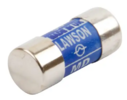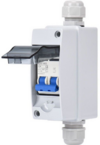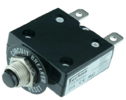I do like the ring final circuit, but I also accept it has a problem where sockets are too close to the origin to ensure the 20 amp per leg is not exceeded.
BS7671:2008 Appendix 15 said:
The load current in any part of the circuit should be unlikely to exceed for long periods the current-carrying capacity of the cable (Regulation 433.1.5 refers). This can generally be achieved by:
(i) locating socket-outlets to provide reasonable sharing of the load around the ring
(ii) not supplying immersion heaters, comprehensive electric space heating or loads of a similar profile frog the ring circuit
(iii) connecting cookers, ovens and hobs with a rated power exceeding 2 kW on their own dedicated radial circuit
(iv) taking account of the total floor area being served. (Historically, limit of 100 m² has been adopted.)
This is clearly to reduce the chance of an over load, but the radial idea does not get away Scot free either, as having unfused spurs from a 4 mm² or 6 mm² cable presents a problem getting the cables into the socket, and using 20 amp causes problem with inrush on items like 110 volt transformers.
I am sure we could today develop another design to get around the problems, but to get it to integrate with what we already have would be the problem. We have to accept the system was designed to be run as a ring final, and accept in general it is still the best system for use with our 13 amp sockets.
I do feel we need a 16 amp fused connection unit taking a fuse something like this

for use on cooker supplies and the like to feed ovens, but from a radial not a ring final, and it would need to be made clear not for use on a ring final. Mainly to allow a 32 amp or larger supply to feed multi items designed for Europe where a 16 amp supply is standard.
However I also see the problems, some one is bound to try fitting one on a ring final. But to me these

may do the job, but are not aesthetically pleasing and I would not want one on my kitchen wall. I am sure a unit like a cooker connection unit could be produced to take one 16 amp fuse. However also the appliance could incorporate an overload like these

so it could be safely supplied from a 40 amp supply, or even a panel fuse.
The
433.2.2 The device protecting a conductor against overload may be installed along the run of that conductor
if the part of the run between the point where a change occurs (in cross-sectional area, method of installation, type
of cable or conductor. or in environmental conditions) and the position of the protective device has neither branch
circuits nor outlets for connection of current-using equipment and fulfils at least one of the following conditions:
(i) It is protected against fault current in accordance with the requirements stated in Section 434
(ii) Its length does not exceed 3 m, it is installed in such a manner as to reduce the risk of fault to a minimum,
and it is installed in such a manner as to reduce to a minimum the risk of fire or danger to persons (see also
Regulation 434.2.1).
I am told does not include unfused spurs, I have not yet worked out why this does not limit the length of an unfused spur, I know it is to allow small cross section cabled from the bus bar chamber to the distribution units within a switch room, but it does not say that, so I would think it does apply to unfused spurs, and those who believe it does not, realise they have run over length unfused spurs and don't want to admit they got it wrong?
The BS 7671 is not published in Welsh, or any other British language other than UK English, and I can understand why, as it is hard enough to prevent any ambiguity in English never mind translating into Welsh. It is so easy to do, I remember the sign on the old A6 before the M6 opened, it said "Beware of the man eating haggis" clearly they wanted the duel meaning, but we don't what that in the regulations, we had this with wires coloured green and yellow, I have seen so many tank thermostats where the green/yellow core was a line wire, but fed with flex and held on with a Bungy cord so not really fixed, so does not require an earth, but ask anyone doing the PAT testing why there is no label on it, and one gets don't be daft that's part of the EICR, and if part of the installation then it needs an earth wire.
This what is current using equipment, and what is part of the installation has been argued about since I started my apprenticeship, we all I think accept lights is part of the EICR in spite of them using current, but it seems nothing else is considered part of the installation. But seen reports with a C2 code for missing smoke alarms, how can some thing being missing what ever it is, cause a potential electrical danger? Unless bare wires left where it should go.




